Design Thinking and Agile Methodologies in Crinitt Venice Project
VerifiedAdded on 2023/06/11
|13
|1341
|111
Report
AI Summary
This report details the application of Design Thinking and Agile methodologies, specifically Scrum, to a project for Crinitt Venice. It outlines the five phases of Design Thinking: empathizing, problem reframing, ideation, prototyping, and testing, explaining how each was approached in the development of an automatic ordering system. The report also describes the Agile methodology, including XP practices and hybrid approaches like Lean software development, Kanban, and Scrumban. Key assumptions made during prototype development are listed, such as market acceptance and future improvements. The conclusion emphasizes the importance of Design Thinking for understanding customer needs and ensuring market success. The document is available on Desklib, a platform offering study tools and resources for students.
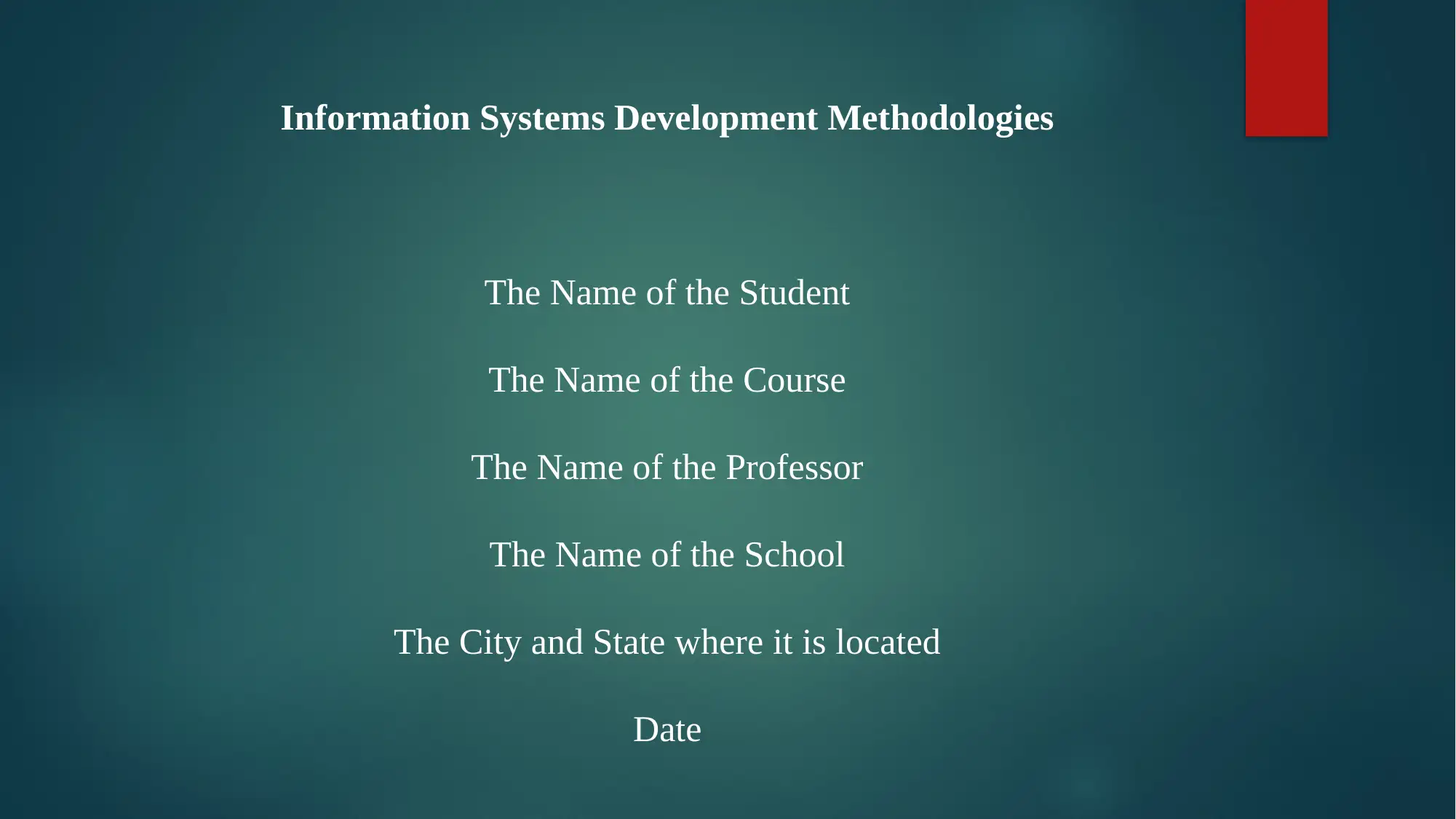
Information Systems Development Methodologies
The Name of the Student
The Name of the Course
The Name of the Professor
The Name of the School
The City and State where it is located
Date
The Name of the Student
The Name of the Course
The Name of the Professor
The Name of the School
The City and State where it is located
Date
Paraphrase This Document
Need a fresh take? Get an instant paraphrase of this document with our AI Paraphraser
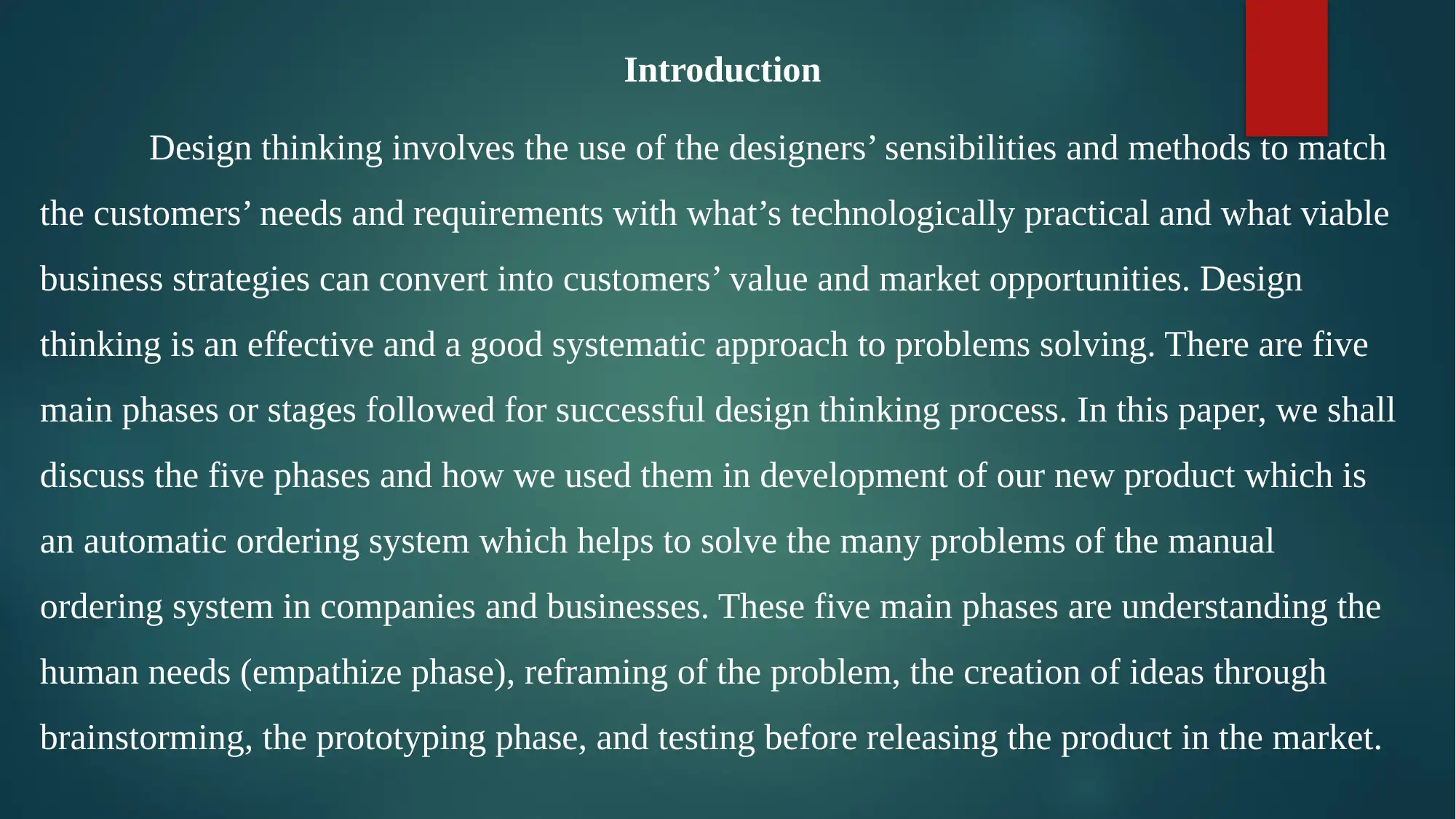
Introduction
Design thinking involves the use of the designers’ sensibilities and methods to match
the customers’ needs and requirements with what’s technologically practical and what viable
business strategies can convert into customers’ value and market opportunities. Design
thinking is an effective and a good systematic approach to problems solving. There are five
main phases or stages followed for successful design thinking process. In this paper, we shall
discuss the five phases and how we used them in development of our new product which is
an automatic ordering system which helps to solve the many problems of the manual
ordering system in companies and businesses. These five main phases are understanding the
human needs (empathize phase), reframing of the problem, the creation of ideas through
brainstorming, the prototyping phase, and testing before releasing the product in the market.
Design thinking involves the use of the designers’ sensibilities and methods to match
the customers’ needs and requirements with what’s technologically practical and what viable
business strategies can convert into customers’ value and market opportunities. Design
thinking is an effective and a good systematic approach to problems solving. There are five
main phases or stages followed for successful design thinking process. In this paper, we shall
discuss the five phases and how we used them in development of our new product which is
an automatic ordering system which helps to solve the many problems of the manual
ordering system in companies and businesses. These five main phases are understanding the
human needs (empathize phase), reframing of the problem, the creation of ideas through
brainstorming, the prototyping phase, and testing before releasing the product in the market.
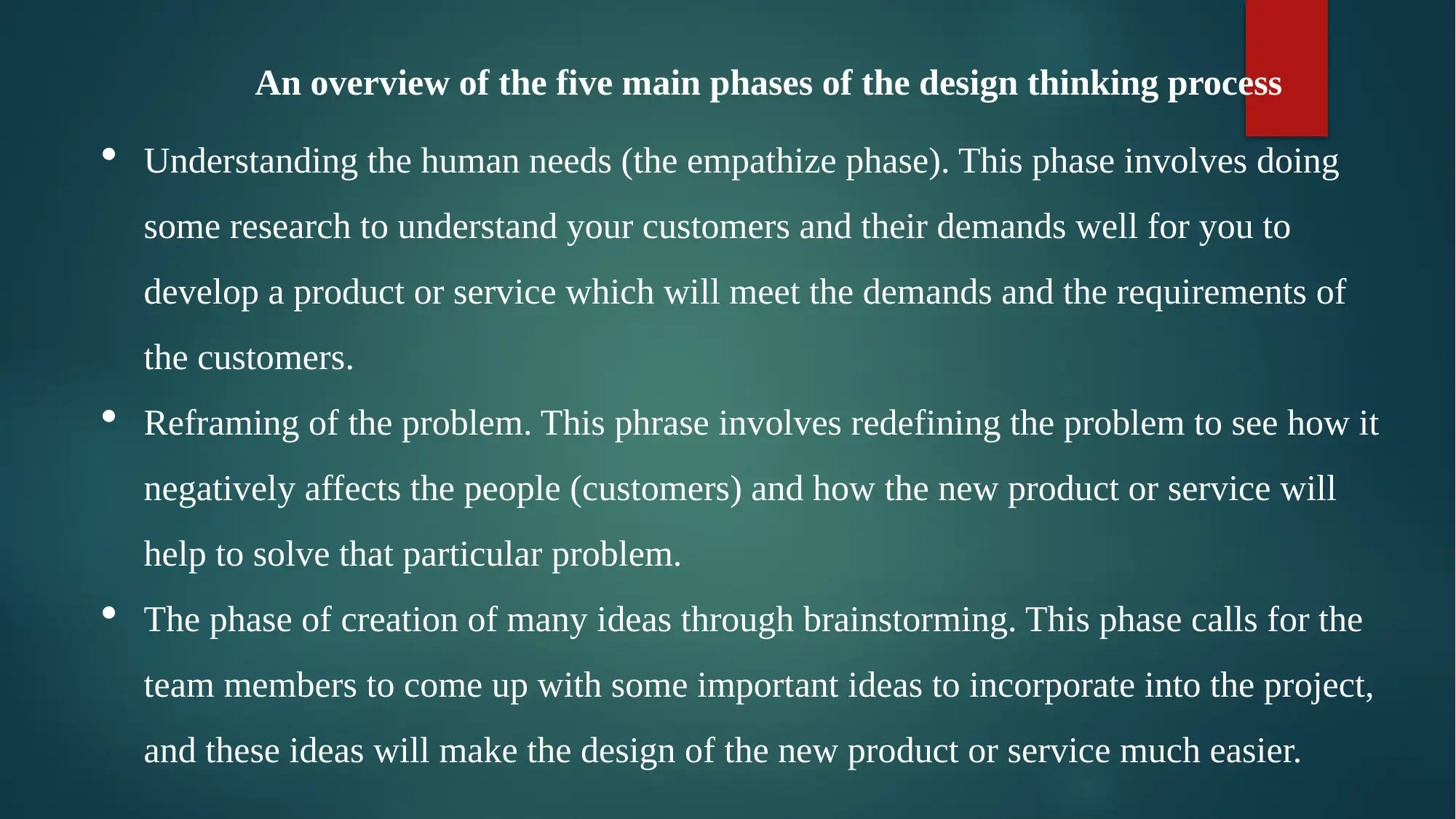
An overview of the five main phases of the design thinking process
Understanding the human needs (the empathize phase). This phase involves doing
some research to understand your customers and their demands well for you to
develop a product or service which will meet the demands and the requirements of
the customers.
Reframing of the problem. This phrase involves redefining the problem to see how it
negatively affects the people (customers) and how the new product or service will
help to solve that particular problem.
The phase of creation of many ideas through brainstorming. This phase calls for the
team members to come up with some important ideas to incorporate into the project,
and these ideas will make the design of the new product or service much easier.
Understanding the human needs (the empathize phase). This phase involves doing
some research to understand your customers and their demands well for you to
develop a product or service which will meet the demands and the requirements of
the customers.
Reframing of the problem. This phrase involves redefining the problem to see how it
negatively affects the people (customers) and how the new product or service will
help to solve that particular problem.
The phase of creation of many ideas through brainstorming. This phase calls for the
team members to come up with some important ideas to incorporate into the project,
and these ideas will make the design of the new product or service much easier.
⊘ This is a preview!⊘
Do you want full access?
Subscribe today to unlock all pages.

Trusted by 1+ million students worldwide
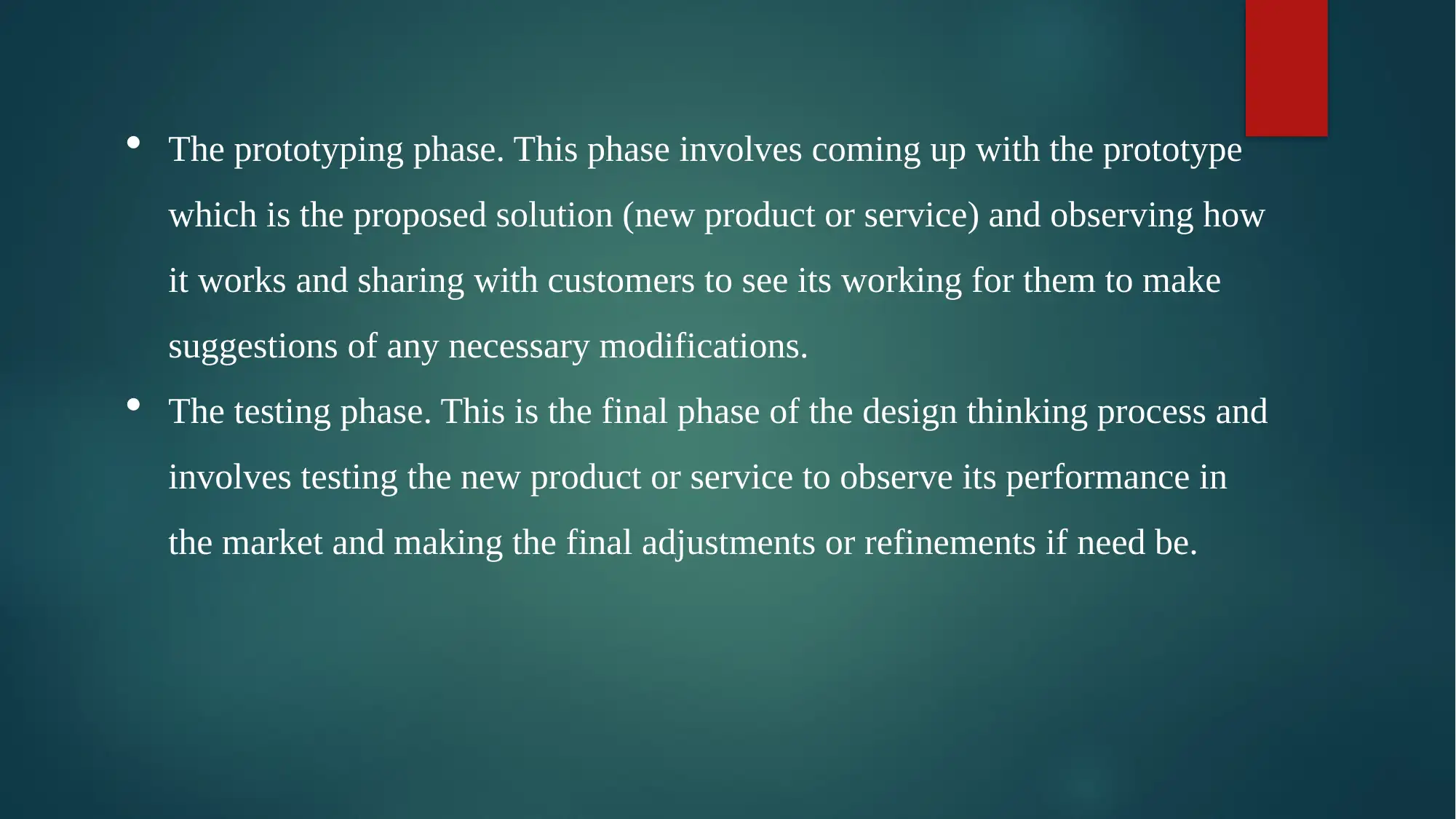
The prototyping phase. This phase involves coming up with the prototype
which is the proposed solution (new product or service) and observing how
it works and sharing with customers to see its working for them to make
suggestions of any necessary modifications.
The testing phase. This is the final phase of the design thinking process and
involves testing the new product or service to observe its performance in
the market and making the final adjustments or refinements if need be.
which is the proposed solution (new product or service) and observing how
it works and sharing with customers to see its working for them to make
suggestions of any necessary modifications.
The testing phase. This is the final phase of the design thinking process and
involves testing the new product or service to observe its performance in
the market and making the final adjustments or refinements if need be.
Paraphrase This Document
Need a fresh take? Get an instant paraphrase of this document with our AI Paraphraser
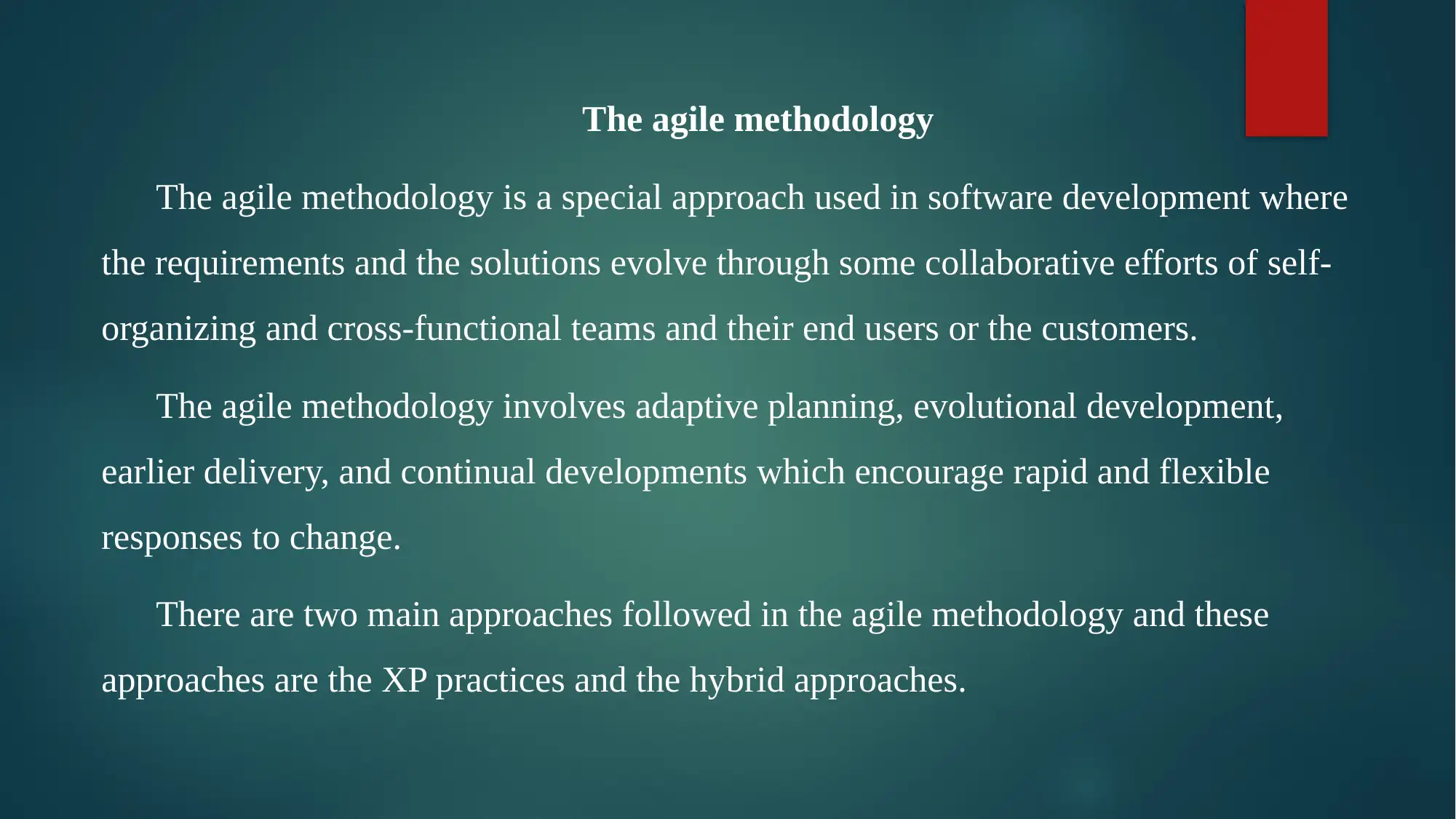
The agile methodology
The agile methodology is a special approach used in software development where
the requirements and the solutions evolve through some collaborative efforts of self-
organizing and cross-functional teams and their end users or the customers.
The agile methodology involves adaptive planning, evolutional development,
earlier delivery, and continual developments which encourage rapid and flexible
responses to change.
There are two main approaches followed in the agile methodology and these
approaches are the XP practices and the hybrid approaches.
The agile methodology is a special approach used in software development where
the requirements and the solutions evolve through some collaborative efforts of self-
organizing and cross-functional teams and their end users or the customers.
The agile methodology involves adaptive planning, evolutional development,
earlier delivery, and continual developments which encourage rapid and flexible
responses to change.
There are two main approaches followed in the agile methodology and these
approaches are the XP practices and the hybrid approaches.
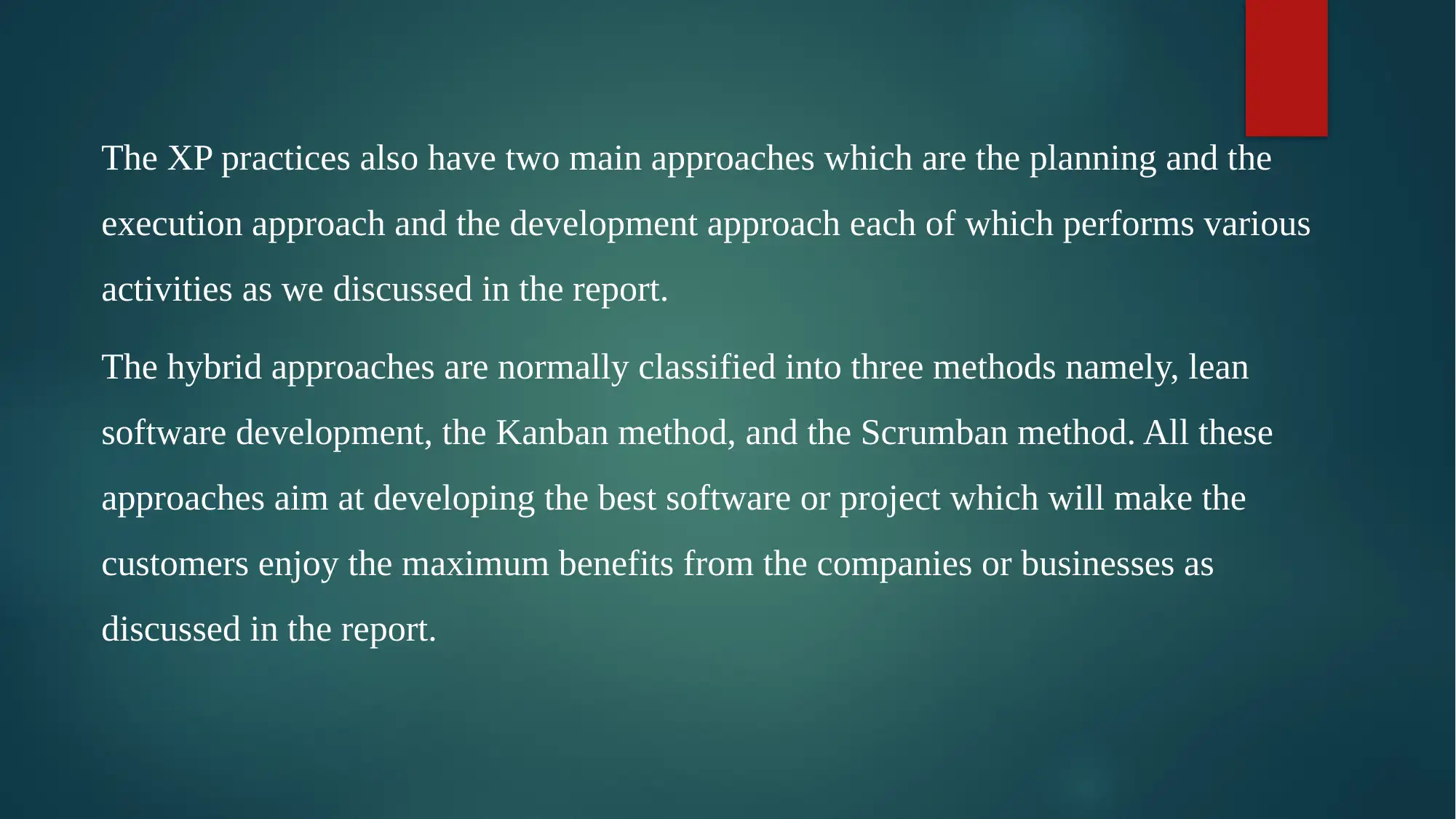
The XP practices also have two main approaches which are the planning and the
execution approach and the development approach each of which performs various
activities as we discussed in the report.
The hybrid approaches are normally classified into three methods namely, lean
software development, the Kanban method, and the Scrumban method. All these
approaches aim at developing the best software or project which will make the
customers enjoy the maximum benefits from the companies or businesses as
discussed in the report.
execution approach and the development approach each of which performs various
activities as we discussed in the report.
The hybrid approaches are normally classified into three methods namely, lean
software development, the Kanban method, and the Scrumban method. All these
approaches aim at developing the best software or project which will make the
customers enjoy the maximum benefits from the companies or businesses as
discussed in the report.
⊘ This is a preview!⊘
Do you want full access?
Subscribe today to unlock all pages.

Trusted by 1+ million students worldwide
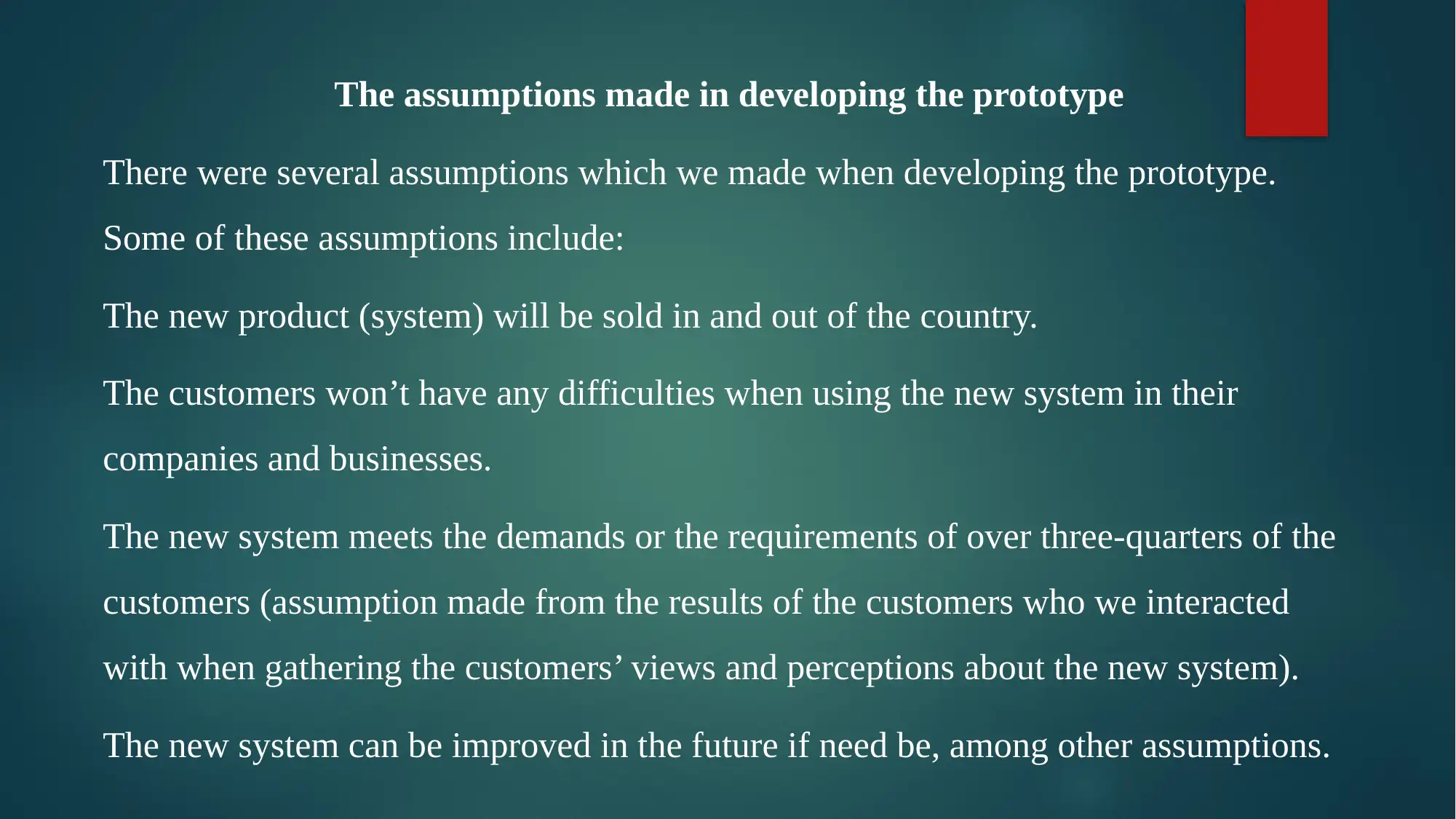
The assumptions made in developing the prototype
There were several assumptions which we made when developing the prototype.
Some of these assumptions include:
The new product (system) will be sold in and out of the country.
The customers won’t have any difficulties when using the new system in their
companies and businesses.
The new system meets the demands or the requirements of over three-quarters of the
customers (assumption made from the results of the customers who we interacted
with when gathering the customers’ views and perceptions about the new system).
The new system can be improved in the future if need be, among other assumptions.
There were several assumptions which we made when developing the prototype.
Some of these assumptions include:
The new product (system) will be sold in and out of the country.
The customers won’t have any difficulties when using the new system in their
companies and businesses.
The new system meets the demands or the requirements of over three-quarters of the
customers (assumption made from the results of the customers who we interacted
with when gathering the customers’ views and perceptions about the new system).
The new system can be improved in the future if need be, among other assumptions.
Paraphrase This Document
Need a fresh take? Get an instant paraphrase of this document with our AI Paraphraser
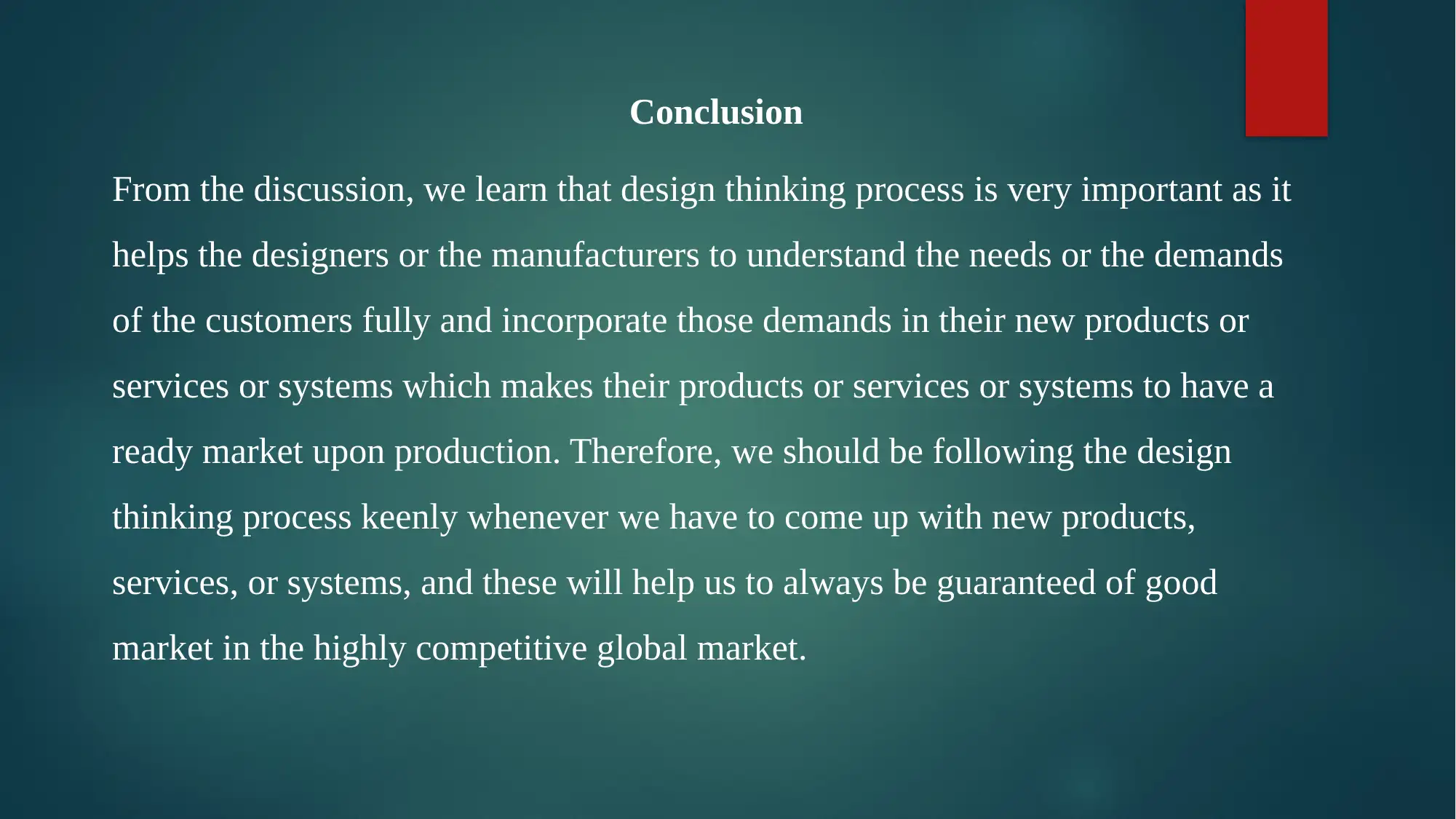
Conclusion
From the discussion, we learn that design thinking process is very important as it
helps the designers or the manufacturers to understand the needs or the demands
of the customers fully and incorporate those demands in their new products or
services or systems which makes their products or services or systems to have a
ready market upon production. Therefore, we should be following the design
thinking process keenly whenever we have to come up with new products,
services, or systems, and these will help us to always be guaranteed of good
market in the highly competitive global market.
From the discussion, we learn that design thinking process is very important as it
helps the designers or the manufacturers to understand the needs or the demands
of the customers fully and incorporate those demands in their new products or
services or systems which makes their products or services or systems to have a
ready market upon production. Therefore, we should be following the design
thinking process keenly whenever we have to come up with new products,
services, or systems, and these will help us to always be guaranteed of good
market in the highly competitive global market.
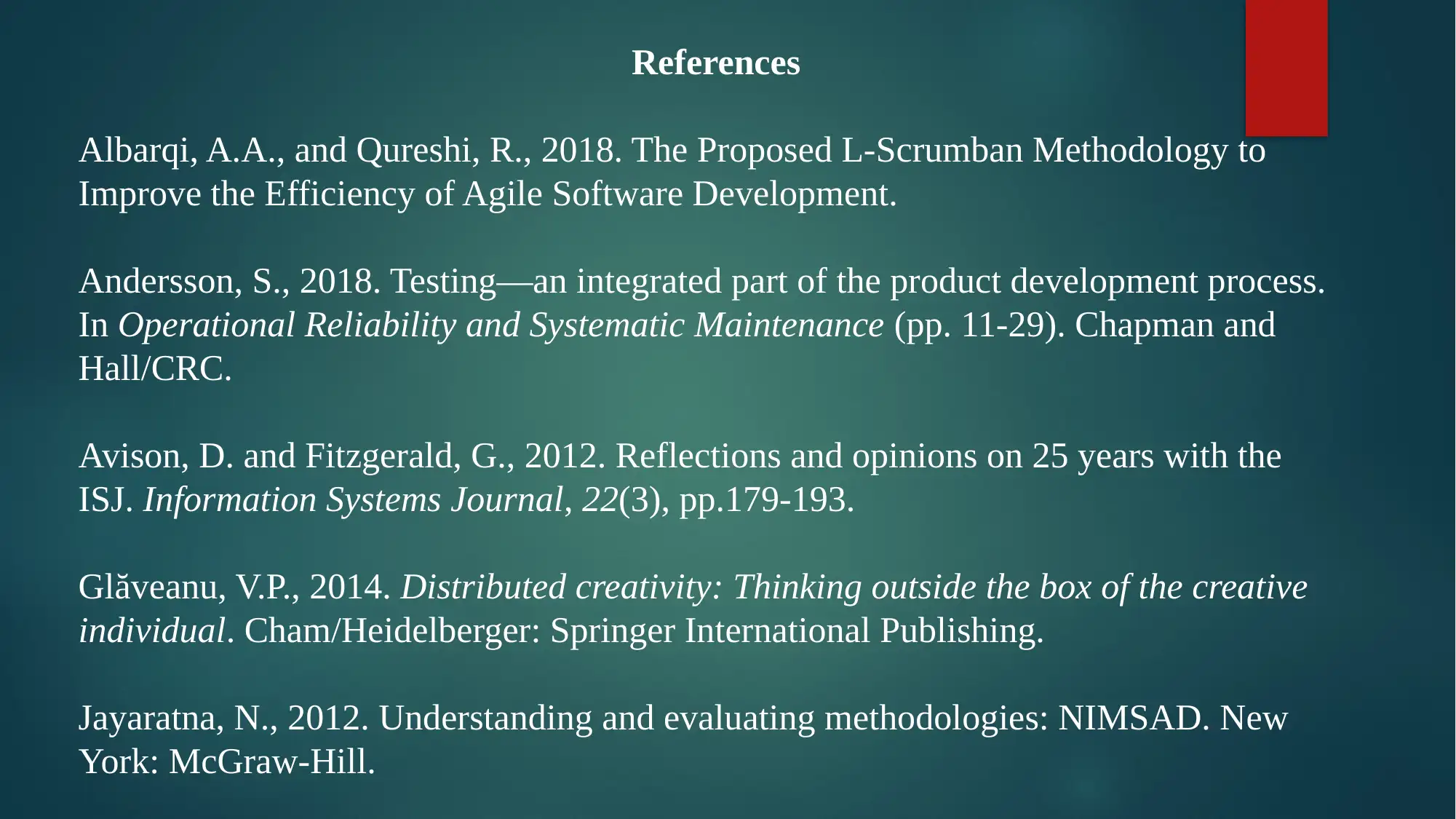
References
Albarqi, A.A., and Qureshi, R., 2018. The Proposed L-Scrumban Methodology to
Improve the Efficiency of Agile Software Development.
Andersson, S., 2018. Testing—an integrated part of the product development process.
In Operational Reliability and Systematic Maintenance (pp. 11-29). Chapman and
Hall/CRC.
Avison, D. and Fitzgerald, G., 2012. Reflections and opinions on 25 years with the
ISJ. Information Systems Journal, 22(3), pp.179-193.
Glăveanu, V.P., 2014. Distributed creativity: Thinking outside the box of the creative
individual. Cham/Heidelberger: Springer International Publishing.
Jayaratna, N., 2012. Understanding and evaluating methodologies: NIMSAD. New
York: McGraw-Hill.
Albarqi, A.A., and Qureshi, R., 2018. The Proposed L-Scrumban Methodology to
Improve the Efficiency of Agile Software Development.
Andersson, S., 2018. Testing—an integrated part of the product development process.
In Operational Reliability and Systematic Maintenance (pp. 11-29). Chapman and
Hall/CRC.
Avison, D. and Fitzgerald, G., 2012. Reflections and opinions on 25 years with the
ISJ. Information Systems Journal, 22(3), pp.179-193.
Glăveanu, V.P., 2014. Distributed creativity: Thinking outside the box of the creative
individual. Cham/Heidelberger: Springer International Publishing.
Jayaratna, N., 2012. Understanding and evaluating methodologies: NIMSAD. New
York: McGraw-Hill.
⊘ This is a preview!⊘
Do you want full access?
Subscribe today to unlock all pages.

Trusted by 1+ million students worldwide
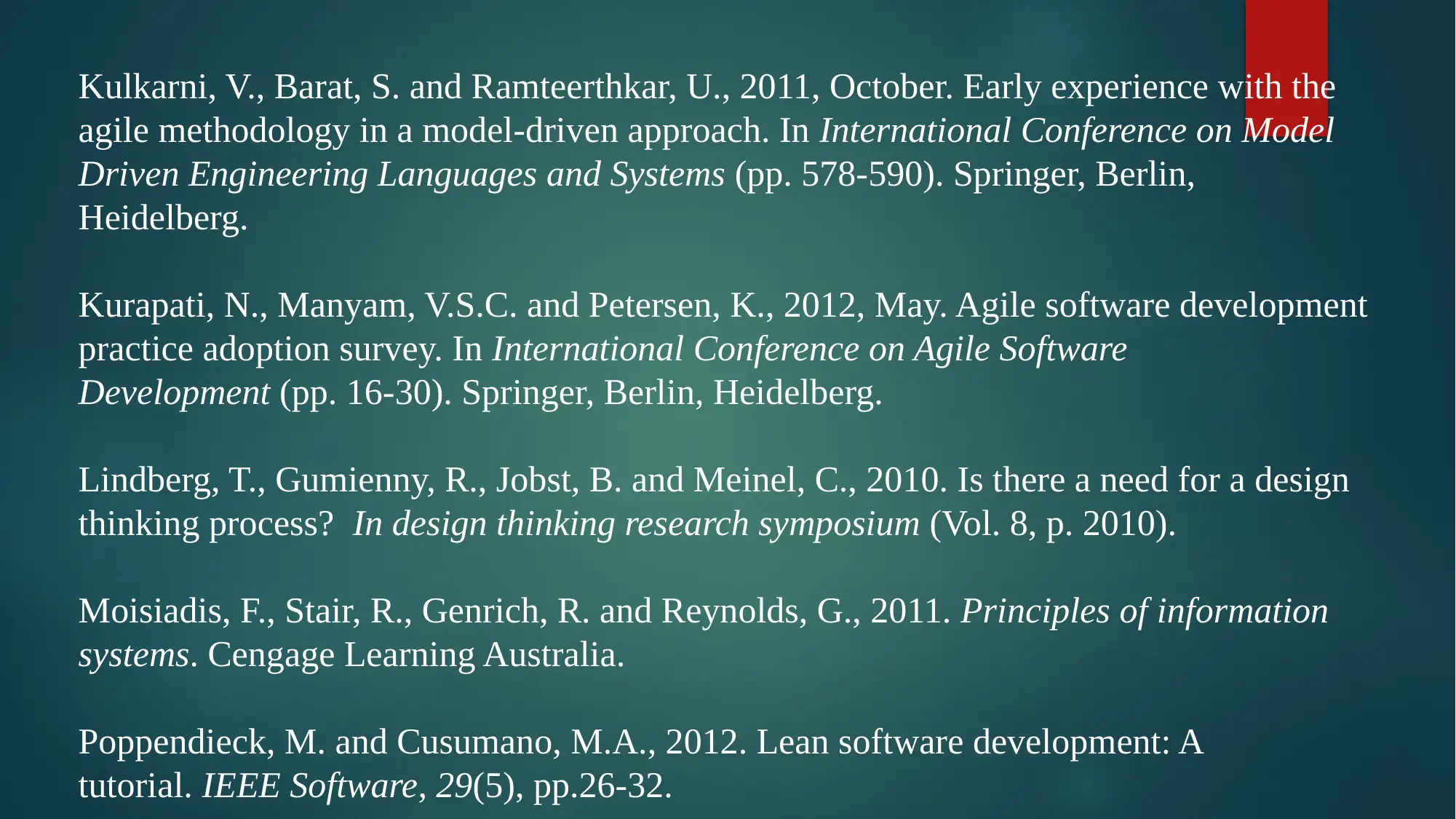
Kulkarni, V., Barat, S. and Ramteerthkar, U., 2011, October. Early experience with the
agile methodology in a model-driven approach. In International Conference on Model
Driven Engineering Languages and Systems (pp. 578-590). Springer, Berlin,
Heidelberg.
Kurapati, N., Manyam, V.S.C. and Petersen, K., 2012, May. Agile software development
practice adoption survey. In International Conference on Agile Software
Development (pp. 16-30). Springer, Berlin, Heidelberg.
Lindberg, T., Gumienny, R., Jobst, B. and Meinel, C., 2010. Is there a need for a design
thinking process? In design thinking research symposium (Vol. 8, p. 2010).
Moisiadis, F., Stair, R., Genrich, R. and Reynolds, G., 2011. Principles of information
systems. Cengage Learning Australia.
Poppendieck, M. and Cusumano, M.A., 2012. Lean software development: A
tutorial. IEEE Software, 29(5), pp.26-32.
agile methodology in a model-driven approach. In International Conference on Model
Driven Engineering Languages and Systems (pp. 578-590). Springer, Berlin,
Heidelberg.
Kurapati, N., Manyam, V.S.C. and Petersen, K., 2012, May. Agile software development
practice adoption survey. In International Conference on Agile Software
Development (pp. 16-30). Springer, Berlin, Heidelberg.
Lindberg, T., Gumienny, R., Jobst, B. and Meinel, C., 2010. Is there a need for a design
thinking process? In design thinking research symposium (Vol. 8, p. 2010).
Moisiadis, F., Stair, R., Genrich, R. and Reynolds, G., 2011. Principles of information
systems. Cengage Learning Australia.
Poppendieck, M. and Cusumano, M.A., 2012. Lean software development: A
tutorial. IEEE Software, 29(5), pp.26-32.
Paraphrase This Document
Need a fresh take? Get an instant paraphrase of this document with our AI Paraphraser
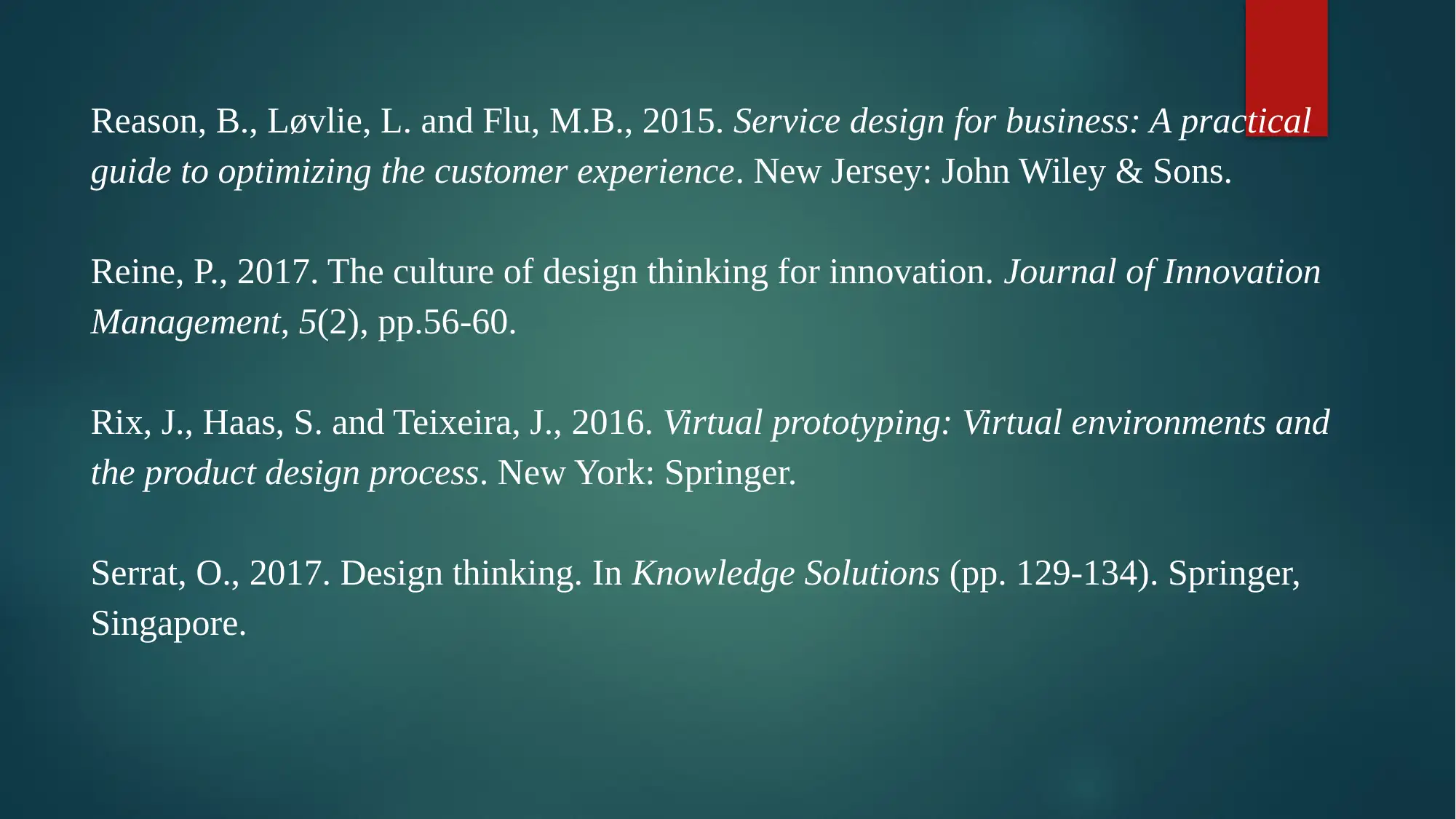
Reason, B., Løvlie, L. and Flu, M.B., 2015. Service design for business: A practical
guide to optimizing the customer experience. New Jersey: John Wiley & Sons.
Reine, P., 2017. The culture of design thinking for innovation. Journal of Innovation
Management, 5(2), pp.56-60.
Rix, J., Haas, S. and Teixeira, J., 2016. Virtual prototyping: Virtual environments and
the product design process. New York: Springer.
Serrat, O., 2017. Design thinking. In Knowledge Solutions (pp. 129-134). Springer,
Singapore.
guide to optimizing the customer experience. New Jersey: John Wiley & Sons.
Reine, P., 2017. The culture of design thinking for innovation. Journal of Innovation
Management, 5(2), pp.56-60.
Rix, J., Haas, S. and Teixeira, J., 2016. Virtual prototyping: Virtual environments and
the product design process. New York: Springer.
Serrat, O., 2017. Design thinking. In Knowledge Solutions (pp. 129-134). Springer,
Singapore.
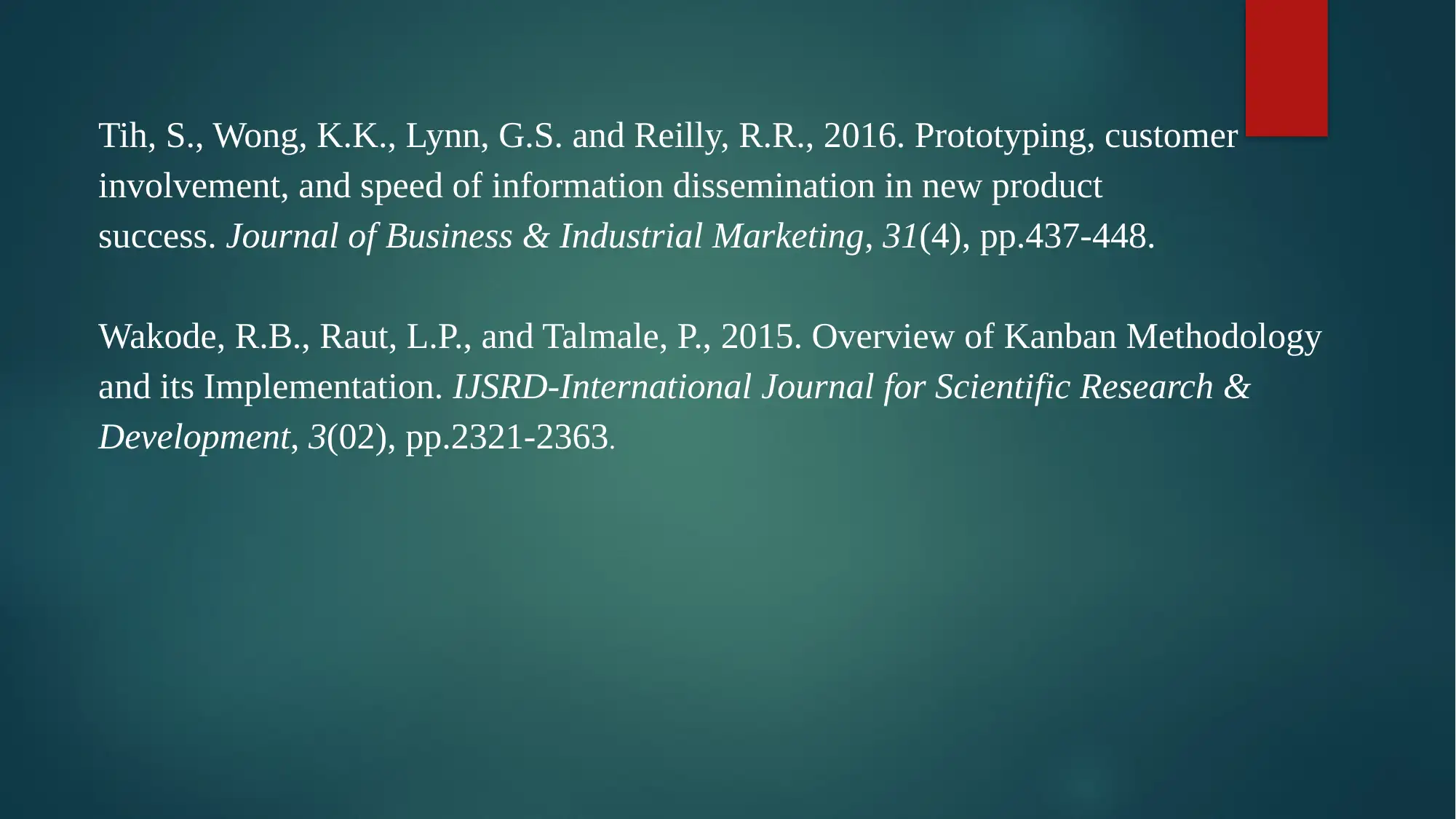
Tih, S., Wong, K.K., Lynn, G.S. and Reilly, R.R., 2016. Prototyping, customer
involvement, and speed of information dissemination in new product
success. Journal of Business & Industrial Marketing, 31(4), pp.437-448.
Wakode, R.B., Raut, L.P., and Talmale, P., 2015. Overview of Kanban Methodology
and its Implementation. IJSRD-International Journal for Scientific Research &
Development, 3(02), pp.2321-2363.
involvement, and speed of information dissemination in new product
success. Journal of Business & Industrial Marketing, 31(4), pp.437-448.
Wakode, R.B., Raut, L.P., and Talmale, P., 2015. Overview of Kanban Methodology
and its Implementation. IJSRD-International Journal for Scientific Research &
Development, 3(02), pp.2321-2363.
⊘ This is a preview!⊘
Do you want full access?
Subscribe today to unlock all pages.

Trusted by 1+ million students worldwide
1 out of 13
Related Documents
Your All-in-One AI-Powered Toolkit for Academic Success.
+13062052269
info@desklib.com
Available 24*7 on WhatsApp / Email
![[object Object]](/_next/static/media/star-bottom.7253800d.svg)
Unlock your academic potential
Copyright © 2020–2025 A2Z Services. All Rights Reserved. Developed and managed by ZUCOL.


